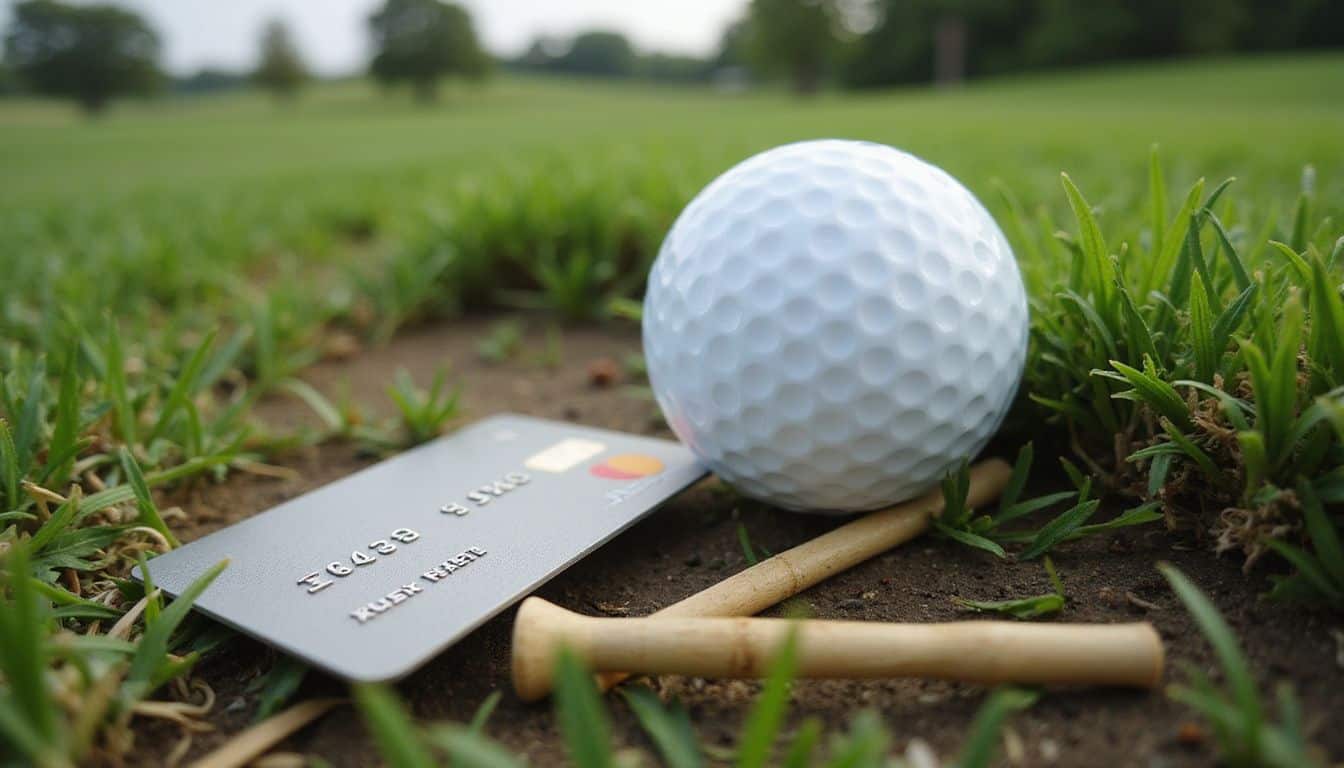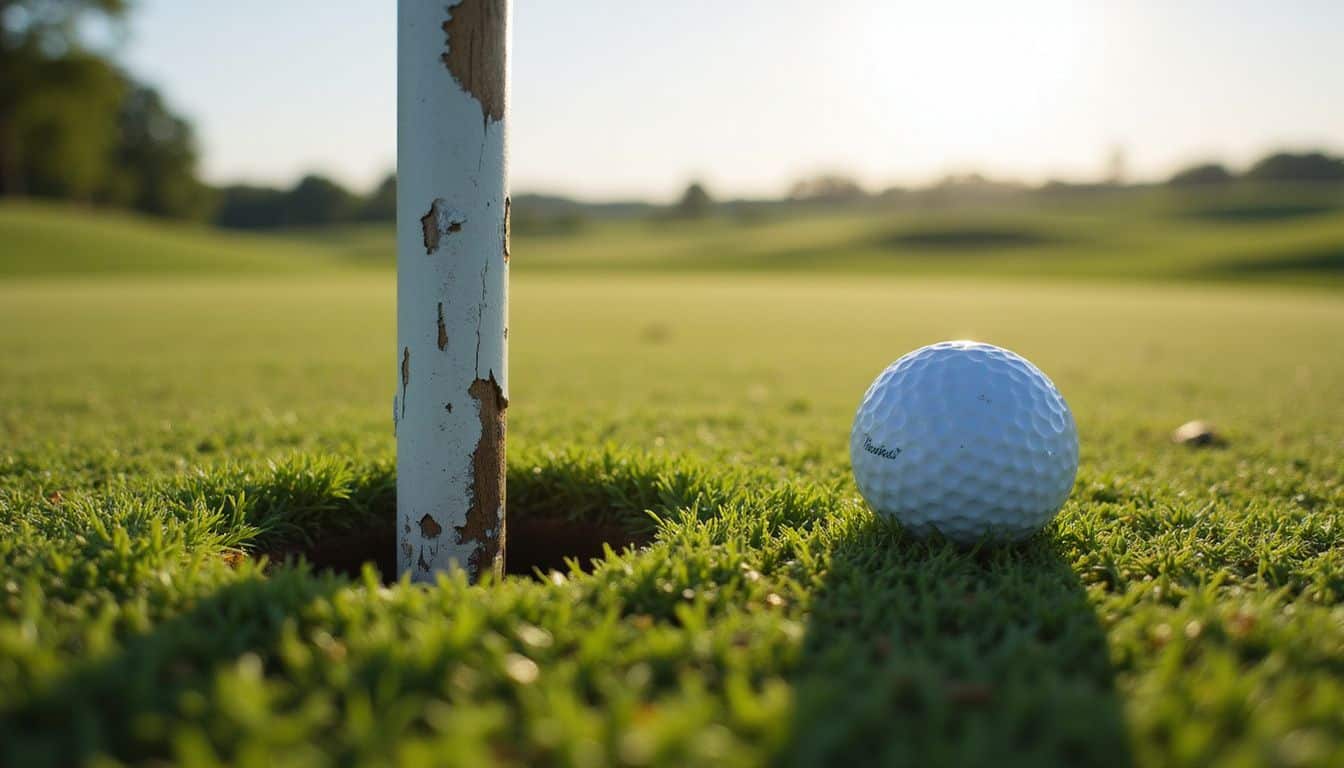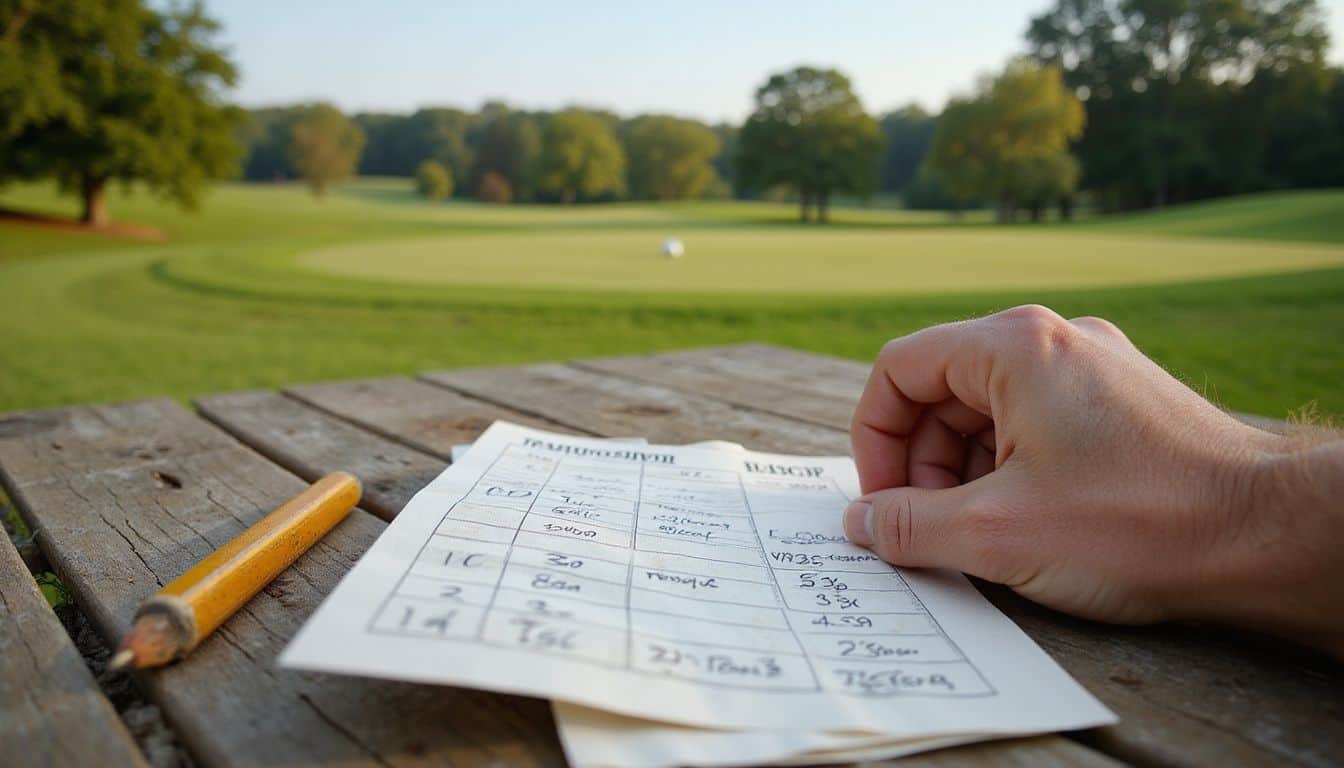You play golf but hate those high scores that ruin your day. Many golfers bend the rules, like improving lies on the fairway or treating out-of-bounds shots as lateral hazards, to shave strokes off their game.
This post shows you how to cheat at golf with 14 sneaky techniques that keep things fun on the golf course. Discover them now.
Key Takeaways
Golfers use 14 sneaky techniques to cheat, like playing multiple balls to pick the best shot and nudge balls for better lies on the fairway.
Rules limit players to 14 clubs, with penalties of two strokes per hole up to four strokes total if extra clubs are found.
Mulligans allow redoing the first drive without penalty, often limited to one per nine holes in casual games.
Gimme putts skip short shots within a few feet, but claiming ones from five feet or more counts as cheating.
By 2025, tech like smartwatches and drones may help cheaters fake scores or find lost balls, as noted by R. Buckminster Fuller on integrity.
Table of Contents
Common Cheating Techniques in Golf

Golfers sometimes play extra balls to pick the best shot and shave strokes off their score. They also nudge their ball to a better spot on the rough, claiming preferred lies even when rules ban it.
How does playing multiple balls affect your score?

Playing multiple balls breaks golf rules and lets you cheat on your score. You hit extra shots from the tee box or fairway, then choose the best one. This boosts confidence and sharpens accuracy, like using irons for better shot quality.
Cheaters often pretend the extra balls count as practice, but it hides poor plays and lowers scores unfairly. In golf cheating, this tactic ignores rules of golf and preferred lies standards.
Guys often use this on tough holes to avoid high numbers, treating it like a free drop from trouble. It improves overall play without penalty, making birdies or eagles seem easy. Bunkers and water hazards become less scary with backup shots ready.
Hit a few extra and pick the winner – that’s how some guys keep their handicap low without real skill. – Anonymous golf buddy
Is it allowed to ground your club in the sand trap?

Golf rules say you cannot ground your club in a sand trap before your shot. Players break this on purpose to test the sand and set a better stance. I once watched a buddy ignore golf etiquette in a casual round, he rested his Callaway club right in the bunker.
That move improved his swing path and boosted his escape. Cheating in golf like this deceives others and hurts golf integrity.
Some guys treat bunkers near greens as spots for sneaky deceptions. They pretend the rule does not apply in friendly games or golf tournaments. Grounding lets you feel the sand’s texture, which aids your setup.
In my experience during weekend play, one player did this and shaved strokes off his score. Such tricks bend out of bounds ethics, yet they tempt many men chasing lower putts.
What are common ways to improve lies on the fairway?

Now that we’ve covered why you can’t ground your club in a sand trap without penalty, let’s shift to the fairway, where sneaky moves can really shave strokes off your score. Guys, improving your lie on the fairway often means bending rules to get that perfect shot. I’ve tried a few of these myself during casual rounds with buddies, and they sure make the game easier, though you risk getting called out.
- One common way involves physically moving the ball to a more favorable position; you just nudge it with your foot or club when no one’s looking, turning a bad spot in the grass into a clean lie for your next swing.
- Another trick is cleaning the ball right there on the fairway; pick it up under the guise of identifying it, wipe off mud or grass, and place it back better than before, which beats dealing with a dirty lie.
- Some players press down the grass around the ball with their shoe; this flattens the area subtly, improving contact without touching the ball itself, and I’ve seen it work wonders on uneven turf.
- You might declare an unplayable lie even when it’s not; take a drop nearby in a better spot, maybe claiming a root or rock is in the way, and continue as if it’s legit.
- For extra edge, use tools like a credit card to scrape debris away discreetly; order one from amazon.com at checkout, have it shipped via USPS, and keep it in your bag for those “emergency” cleans.
- Finally, improve lies by teeing up slightly in the rough edging the fairway; act like it’s still fairway grass, hit from there, and enjoy the hobbies that require skill like golf without the hassle of a tough position.
Can you take free drops from rocks or roots?

Golf rules let you take a free drop if your ball sits near rocks or roots that could harm your club or you. You avoid potential club damage or injury this way. Spot the danger first.
Then drop the ball within one club length, no closer to the hole. Keep it simple and quick to stay in the game.
Integrity is the essence of everything successful. – R. Buckminster Fuller
Players often bend this rule for an edge. They claim free drops even when no real risk exists. Watch for that sneaky move. Some guys use it to get a better lie without penalty. Next up, learn how players treat out-of-bounds shots as lateral hazards.
How do players treat out-of-bounds shots as lateral hazards?

Players sometimes handle out-of-bounds tee shots like lateral hazards to cheat. They drop a new ball near the spot where the original went OB, instead of re-teeing with a penalty. This trick cuts down on strokes, guys, and keeps the game moving fast.
I’ve pulled this off in casual rounds with buddies; we agree upfront to treat white stakes as red ones, saving time on busy courses. It reduces the usual two-stroke hit, turning a big setback into a minor one.
You spot this when someone claims their ball crossed a boundary but drops sideways, not back at the tee. Rules say OB means stroke and distance penalty, but cheaters bend that for pace.
My group once used it on a tight hole with houses nearby; we dropped quickly and played on, avoiding delays. This method helps groups finish rounds quicker, especially in fun games among friends.
What does dropping on the far side of water hazards mean?

Dropping on the far side of water hazards lets you skip strokes in a sneaky way. You hit your ball into the water, but instead of dropping near the entry point, you pick a spot on the opposite bank.
Rules say you drop at an equal distance from the hole, which often puts you closer to the green. This cuts your penalty and saves time. Golfers use this trick to avoid extra shots back over the hazard.
I tried this once during a casual round with buddies, and it shaved two strokes off my score on a tough par-4. You measure the distance carefully from where the ball crossed the water.
Drop the ball there, add your penalty stroke, and keep playing. Critics call it bending rules, but some guys swear by it for fun games. Just watch out for strict groups that enforce every detail.
What are mulligans and how do they affect the first drive?

Mulligans let golfers redo a bad shot without penalty. Guys often use them on the first drive, especially without range practice to warm up. This trick, known as Technique #9, keeps the score clean in casual rounds.
Players hit a second ball if the first one slices into trouble. That original shot vanishes from the tally. Mulligans do not count against a player’s score in informal play. I recall my buddy pulling this on our weekend game last summer; he shanked his opener into the woods, grabbed another tee, and drove straight down the fairway like nothing happened.
A mulligan turns a rough start into a fresh chance – perfect for us guys skipping the practice swings.
These moves bend rules but add fun among friends. You declare it right away to avoid arguments. Smart players limit them to one per nine holes. This keeps things fair yet sneaky.
How does capping scores at triple bogeys work?

Mulligans let you redo that bad first drive, but sometimes you need more help to keep your score in check. Capping scores at triple bogey acts as technique number eight in sneaky golf play.
You limit your hole score to triple bogey, no matter how many strokes you actually take. This trick cuts down your total score fast. It also keeps the game moving without endless hacks on a tough hole.
I tried this once on a brutal par four where I racked up eight strokes; I just wrote down seven instead. Golf rules don’t allow it, but among buddies, it maintains pace and avoids frustration.
Players pick this method to manage their card without admitting every mistake. Tools like scorecards and pencils make it easy to adjust on the fly. Concepts such as bogey limits turn into handy cheats for casual rounds.
What counts as a gimme putt that is too long?

Guys, a gimme putt lets you skip holing out on short shots. You assume the ball goes in without tapping it. This trick, known as Technique #11, saves time and strokes. Players often agree on gimmes for putts within a few feet.
That distance feels fair in casual games. Stretch it too far, and you cross into cheating. A putt from five feet or more? That counts as too long for a true gimme.
Some dudes push the limit to shave points off their score. They call a knee-knocker from across the green a gimme. Rules don’t allow that in strict play. Stick to short ones, like those inside the leather of your putter grip.
Groups set their own standards, but honesty keeps the game fun. Claim a long one, and friends might call you out. It bends trust on the course.
How do players pretend a lost ball isn’t lost?

Another sneaky way to fudge your score ties right into those long gimmes – some guys just act like a missing ball never happened at all.
Players pretend a lost ball isn’t lost by falsely claiming they’ve found it, even when it’s gone for good. This skips the penalty strokes that rules demand. Technique #12 highlights this cheat; you avoid the stroke-and-distance penalty by dropping a new ball and playing on as if nothing occurred.
I’ve done rounds where a buddy swore he spotted his ball in the rough, but we all knew it was lost – he just pocketed an extra and claimed victory to shave points off his score. You search quickly, then declare it “found” without proof.
Others yell “There it is!” from afar, planting doubt in the group’s mind.
I found it right here, no problem, he said, dropping a fresh ball slyly.
Cheaters use this to treat out-of-bounds shots like simple hazards, ignoring the real rules.
Rule Bending on the Course

Golfers sometimes stretch the rules to gain an edge, like placing the ball ahead of the markers on the teeing ground or keeping the pin in during putts from the green. Players might carry more than 14 sticks in their bag and skip strict pro guidelines, all while checking the PGA Tour schedule for upcoming events.
Is it acceptable to tee up in front of the tee box?

Guys, teeing up your ball in front of the tee box breaks the rules plain and simple. This sneaky move, known as technique #13, lets you gain a better lie or angle for your shot. It might seem harmless, but officials call it a penalty every time.
I tried it once on a tight par-4 hole, and man, it opened up the fairway like magic. Still, the guilt hit hard after.
The rules demand you stay between or behind the markers. Step forward, and you risk a two-stroke hit, or worse in match play. Players sneak this for extra yards off the driver, dodging rough or hazards.
My buddies and I spotted a guy doing it last summer; we called him out, and the round got tense fast.
When can you leave the flagstick in while putting?

While we’re on the subject of bending rules from the tee box, let’s shift to the green where another trick comes into play. You can leave the flagstick in while putting, and it simplifies things a lot.
Rule 13.2 lets you do this without any penalty. Players use this as technique #10 to make putting easier, especially on long putts. The flagstick stays right in the hole, and your ball can even hit it.
No one needs to tend or remove it anymore.
I’ve tried this myself during a casual round with buddies, and it sped up our game big time. We kept the flagstick in for every putt, and it cut down on those annoying delays. This rule change makes sense for faster play.
You avoid the hassle of pulling it out each time. Just line up your putt and go for it. Your group moves quicker, and you focus more on your stroke.
What happens if you use extra clubs beyond the limit?

Golf rules limit you to 14 clubs in your bag. Break that rule, and you face penalties. Officials add two strokes per hole if they spot the extra club. This caps at four strokes total for the round.
You might slip by in a casual game with buddies, but pros catch it fast.
Spot the issue between holes? Remove the extra club right away. Keep playing without it to avoid more trouble. Guys often stash an extra wedge or putter for tough spots. That choice risks your score and rep on the course.
How do players ignore professional rule standards?
Extra clubs might slip past notice in a casual round, but some guys push boundaries further by flat-out ignoring pro-level rules to gain an edge. They misreport scores on purpose, shaving strokes here and there to create an illusion of skill that fools buddies and boosts egos.
This tactic lets them claim a lower handicap without the real work.
Players also bend rules with improved lies, kicking the ball to better grass or pressing down rough to enhance shot conditions. They treat strict guidelines, like those from the USGA, as suggestions only.
Such moves keep the game fun for them, yet they risk getting called out in a group that values fair play.
What scorecard inconsistencies suggest cheating?
Guys, watch for scores that don’t add up on the card. Players cheat by using “magic pencils” to erase and rewrite lower numbers. They misreport shots too. Look at totals that seem off from what you saw during the round.
This happens often with hidden strokes.
Spot failures to note rule breaks, like air shots or bad drops. Cheaters skip declaring these penalties. Their card shows clean holes, but you recall the mess-ups. These signs point to foul play.
Keep an eye on those details next time you play.
How to identify questionable dropping techniques?
Watch for players who drop their ball too far from the spot where it entered a penalty area. They often misjudge or fabricate those entry points to gain extra yards. This improper drop technique gives them an unfair edge, like placing the ball on smoother grass instead of rough.
I once spotted a buddy do this during a casual round; he claimed his shot crossed the hazard way ahead, but I knew it didn’t.
Spot cheaters who bend rules by dropping from knee height but then nudge the ball into a better lie. Rules demand a straight drop without improvement, yet some guys fabricate stories about rocks or roots to justify free relief.
These moves exploit penalty areas for advantage. In my experience playing weekend games, I’ve caught folks pretending a bad shot never happened by dropping slyly on the fairway’s edge.
What are signs of overly convenient ball placements?
Guys, spot a cheater when his ball always lands in a spot that’s just too perfect, like right on a flat patch after a wild shot into the rough. Players sneakily move their ball to improve its lie when they think no one is watching, turning a tough spot into an easy one.
I’ve caught buddies doing this in my weekend games; their ball suddenly appears on mowed grass instead of thick weeds.
Look for drops that seem off, too. Some guys use improper drops and relief techniques; they drop the ball from incorrect heights to get a better position. In one round I played, a guy claimed relief from a root but dropped knee-high instead of shoulder-high, landing his ball in prime fairway territory.
These moves scream foul play.
How does cheating impact fellow players?
Cheating in golf creates distrust among your playing partners. You break the trust that holds the group together. This leads to frustration on the course. Players feel annoyed when scores seem unfair.
It sparks conflicts during the round. Disputes arise over rules and drops. No one enjoys that tension. Golf stays fun when everyone plays straight.
Your buddies start questioning every shot. They watch you closer, and that kills the vibe. Cheating turns a good day into a mess of arguments. It ruins the camaraderie men seek in golf.
Now, let’s talk about the reputation risks of cheating.
What are the reputation risks of cheating?
Guys, if you cheat at golf, you risk trashing your good name fast. People start seeing you as untrustworthy on the course and off it. I recall a buddy of mine who fudged his score once during a casual round; word spread quick, and folks stopped inviting him to games.
That slip damages a player’s reputation and credibility for good. It can even lead to disqualification and exclusion from tournaments, shutting doors on future play.
You lose respect from your playing partners too, making every round tense. No one wants that label sticking to them. This brings us to why golf stands as a game of integrity.
Why is golf considered a game of integrity?
Golf demands honesty from every player. You call your own penalties, with no referees watching your every move. This self-policing builds trust among guys on the course. Integrity shines when you value patience and discipline more than low scores.
I recall a round where I faced a tough lie in the rough; instead of nudging the ball, I played it straight and felt that rush of real accomplishment.
True success comes from authentic improvement and skill growth, not shortcuts. Camaraderie grows strong when everyone plays fair, sharing laughs over honest mistakes. Guys who embrace this ethos form lasting bonds, turning golf into more than a game.
It fosters character, rewarding those who develop their swing through practice, not tricks.
How Will Cheating in Golf Evolve in 2025?

Tech gadgets will change the game for sneaky players. Smartwatches already track swings, but by 2025, they might hide apps that suggest illegal drops or fake scores. Guys like us could use drones to spot lost balls from afar, turning a penalty into a quick find.
I once tried a basic GPS device during a round, and it helped me bend rules without anyone noticing. Expect augmented reality glasses to show hidden lies or even alter ball positions virtually for disputes.
Players will pair these tools with voice assistants that whisper advice on capping holes at double bogey.
Courses might add more cameras, yet cheaters will adapt fast. Some men will hack score apps to erase bad shots before submitting. Mulligans could go digital, with groups agreeing on virtual do-overs via phones.
In my experience, friends have used group chats to cover up out-of-bounds lies during casual games. Water hazards? Apps might calculate fake carry distances to justify better drops.
Integrity stays key, but these tricks will tempt even honest players to push limits.
People Also Ask
What are some sneaky techniques to cheat at golf?
You can nudge your ball with your foot when no one looks, or mark your scorecard wrong on purpose. These tricks help lower your score fast, but watch out for getting caught. Just remember, they bend the rules in clever ways.
Is it okay to use sneaky techniques during a friendly golf game?
Sure, if everyone’s in on the fun, these cheats add laughs to the round. But in serious play, they might get you banned.
How do these 14 sneaky techniques help improve my golf score?
They let you tweak lies, hide strokes, or even swap balls secretly… all to shave points off your total. Players try them for an edge, yet real skill beats cheating every time. Practice honestly if you want lasting wins.
What risks come with trying to cheat at golf using these methods?
You could face penalties, lose friends, or ruin your reputation on the course. Sneaky moves seem smart at first, but they often backfire hard.
References
https://outofboundsgolf.com/how-do-you-cheat-at-golf/
https://www.businessinsider.com/14-ways-people-cheat-at-golf-2012-6
https://forum.mygolfspy.com/topic/6177-14-most-common-ways-people-cheat-at-golf/
https://collegiategolf.com/news/583-usga-rules-water-hazards
https://blog.ncga.org/rule-of-the-month-the-flagstick
https://forums.golfwrx.com/topic/247300-rule-question-when-to-pull-the-flagstick/
https://westessexgolfclub.co.uk/how-many-golf-clubs-can-you-carry/
https://www.hole19golf.com/the-19th-hole/7-common-ways-golfers-cheat (2025-01-29)
https://tablehopping.com/how-to-spot-a-golf-cheat/
https://www.golfmonthly.com/features/how-to-spot-a-golf-cheat
https://essential.golf/how-to-spot-a-golf-cheat/
https://mohicanhillsgolfclub.net/how-to-cheat-in-golf/ (2023-05-11)

